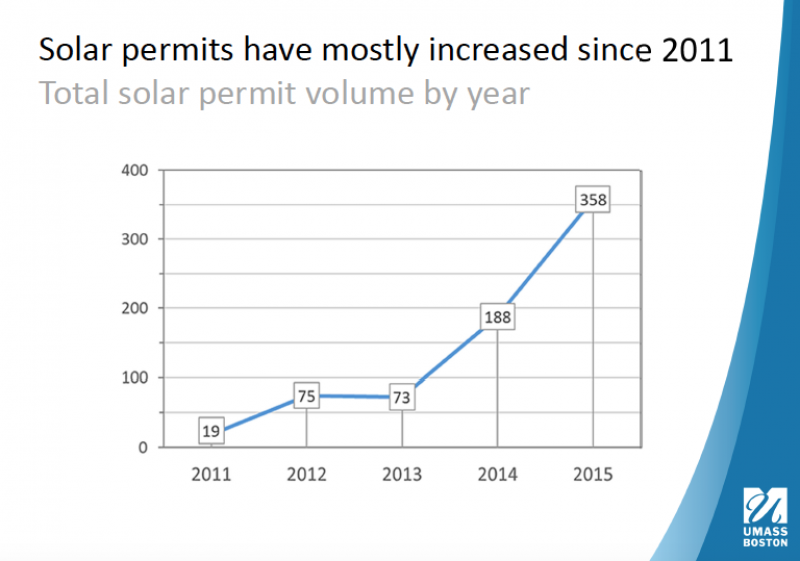Homeowners opt for solar panels in Dartmouth
For Liz Moniz, a resident of North Dartmouth, solar panels were a no brainer for her and her spouse. She said that, as an employee of The Lloyd Center, she tries to find ways to be environmentally conscious. But the savings were a major selling point.
“Our electric bill yesterday was negative-ninety-nine dollars,” said Moniz.
Drivers will likely see more signs popping up around town instructing the viewer to look up. These arrows point toward solar panels installations, and there have been plenty of these projects in the works recently.
Data on the Town’s solar permits reveal a steady trend over the past five years of homeowners opting for solar panels. In 2013, the number of permits issued for panels was 73. In 2014, that number climbed to 188. Last year, it jumped to 358.
Dartmouth has seen a trend toward sustainability in recent times. An upcoming education center at Round the Bend Farm hopes to teach students about food systems. UMass Dartmouth’s executive chef is growing his own lettuce for students in the winter. The Lloyd Center for the Environment has plans to create the state’s second Living Building Challenge-certified structure.
“It’s a definite culture shift in Dartmouth,” said Town Administrator David Cressman. “Probably even before 2009, Dartmouth started to buy into support of sustainable energy and living. I think we’ve shifted into the solar mode, and I think it’s exploded as we can see in the last year.”
These trends in Dartmouth match trends happening elsewhere in Massachusetts. According to state data, there were 67,348 residential panel installations in 2014. Last year, that number climbed to 130,338.
“Residents, businesses, municipalities and state agencies have created tremendous solar growth across the Commonwealth,” said Department of Energy Resources Commissioner Judith Judson in an emailed response. “With prices coming down and easy access to low interest loans through our Mass Solar Loan program, we expect that individuals and families will continue to invest in clean energy options like solar.”
Moniz factored in renewable energy while she was working toward upgrading her house.
“We bought a home that was built in the ‘80s, and it had some older systems,” said Moniz. “We were trying to update those systems, like the heating and electric, in a way to save money on the front end as a new homeowner.”
Her roof is at a steep pitch, meaning the recent snow storm that hit town rolled off her panels. She said her backyard sees plenty of sun throughout the morning. Solar panels work best on South-facing roofs.
“We don’t pay the utility for electric, but we are paying our panel debt because we want to own the panels eventually,” said Moniz. “Not everybody does that. We saw an opportunity that, when our panels are paid off in ten years, all of the money comes to us.”
Moniz recommends that anyone interested in panels shop around first. She consulted with three companies before settling on a pay-to-own model through Real Goods Solar.
“Solar is not a one-size [fits all] scenario,” said John Ordoña, vice president of communications at the California-based solar company Sungevity. “It depends on the customer’s situation – their usage, their house, their lifestyle. It is important to work with a company that offers you options and flexibility in terms of how to provide you with the solar service that you need specifically.”
Homeowners can buy, lease or rent to own solar panels.
Buying solar panels comes with a steep initial cost. Depending on the number of panels the homeowner would want on their roof, the cost of installation can range from $9,000 to $50,000.
The state has several options for customers to help lessen the burden of making the investment. Massachusetts is a state that allows solar panel owners to benefit from Solar Renewable Energy Credits, which enables a utility to take credit for the clean energy produced by the homeowner. These credits can help the homeowner get a return on investment from the panels.
Net metering is another way that customers can save cash. Net metering essentially allows homeowners to run their meters backward. When a solar user produces more energy than needed for a household, the meter runs backward and the customer receives a credit. At the end of the month, if there is a net credit, that credit is applied to the utility bill, and it’s roughly equal to the retail rate of energy.
Those credits carry over from month. Customers will likely generate more credits during the summer and use the credits in the winter when the system is producing less.
“You also have federal income tax credits, which are for customers who are looking to buy,” said JP Gerken, vice president of sales at Sungevity. “If they have the taxable income required, they’re able to take advantage of a thirty percent federal income tax credit.”
As far as leasing is concerned, while it may save homeowners upfront, a study from the Massachusetts Department of Energy Resources found that buying to own leads to more savings over time than leasing.
Moniz said, as a new homeowner, the renting-to-own model worked well for her because it's a long-term investment. Someone looking to sell their home in the next 10 years would likely want to pursue another path.
While all the options for homeowners may seem staggering, the information users can acquire about their new investment is straightforward. Homeowners can track how much energy the panels are producing and how much they are saving through an app or through computer software.
“One of the things I’ve enjoyed the most about it is, through the system that I have, I’m able to look at my production value,” said Moniz. “I could sign on right now and tell you how much energy I’m producing, [and] how much I produced yesterday. I get instant feedback from my panels, and it’s gratifying to see.”

















